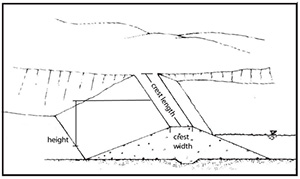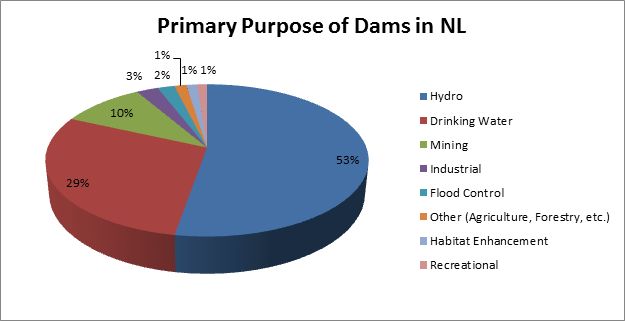- Background
- What is a Dam?
- Responsibility of Dam Owners
- Consequences of Dam Failure
- Design and Approval of Dams
- Operation of Dams
- Dam Safety Training
- Related Links
- Contact Information
- Gullbridge Dam and Town of South Brook
- Deer Lake Seepage Issue (1 MB)
- Dam Safety Publications and Reports
Background
The provincial Dam Safety Program is meant to oversee the safe management of dams in Newfoundland and Labrador. Dam safety management entails the management of risks associated with dams to public safety, infrastructure, and the environment. The principles of dam safety apply at all stages of a dam’s life cycle (design, construction, operation, and decommissioning).
There are over 600 dams in Newfoundland and Labrador. Dams in the province fall under the legislative authority of the Water Resources Act, 2002 . The primary purpose of dams in the province include: hydro power generation, drinking water supply, mine tailings management facilities, recreational use, industrial supply, flood control, and habitat enhancement.
What is a Dam?
A dam is a barrier constructed for the retention of water. The province recognizes the following two definitions of a dam:
| Type of Dam | Definition |
|---|---|
| Canadian Dam Association (CDA) Dam | A barrier constructed for the retention of water, water containing any other substance, or tailings that:
|
| Very Small Dam | A barrier constructed for the retention of water, water containing any other substance, or tailings that is 1.0 m or greater and less than 2.5 m in height. |

The height of the dam must be measured from the top of the dam to the natural bed of the stream or watercourse at the downstream toe, or from the lowest elevation at the outside limit of the dam. The term dam is inclusive of all appurtenances and systems incidental to, necessary for, or connected with the dam. Different types of water control structures that may be classified as dams include dams, canals, weirs, tailings dam, stormwater detention or retention pond berms, dykes, and sedimentation pond berms. Please contact the Department of Municipal Affairs and Environment regarding questions on whether a structure is classified as a dam or not.
Responsibility of Dam Owners
A dam owner is the person or legal entity that is responsible for the safety of the dam. The dam owner is responsible for keeping the dam in good repair and ensuring that the structure is maintained and operated safely. Other responsibilities of a dam owner:
| Type of Dam | Responsibility |
|---|---|
| CDA Dam |
|
| Very Small Dam |
|
Dam Owner Annual Dam Safety Report
Consequences of Dam Failure
There are many possible human or natural causes of dam failure. The human causes of dam failure include poor design and construction, improper maintenance, or inappropriate operation. Storms, earthquakes, and mudslides and other natural causes could compromise the strength of a dam and also cause a dam to fail.
The consequences of a dam failure can include:
- Potential loss of life for the population at risk (permanent or temporary)
- Environmental losses
- Cultural losses
- Infrastructure losses
- Economic losses
According to the CDA, dams must be classified on the basis of the consequences of the dam failing. The following dam classification scheme should be used to provide guidance on the standard of care expected of dam owners and designers.
Table 1: Dam Classification
| Dam Class | Population at Risk [Note 1] |
Incremental Losses | ||
|---|---|---|---|---|
| Loss of Life [Note 2] |
Environmental and Cultural Values | Infrastructure and Economics | ||
| Low | None | 0 | Minimal short-term loss No long-term loss |
Low economic losses; area contains limited infrastructure or services |
| Significant | Temporary Only | Unspecified | No significant loss or deterioration of fish or wildlife habitat Loss of marginal habitat only Restoration or compensation in kind highly possible |
Losses to recreational facilities, seasonal workplaces, and infrequently used transportation routes |
| High | Permanent | 10 or Fewer | Significant loss or deterioration of important fish or wildlife habitat Restoration or compensation in kind highly possible |
High economic losses affecting infrastructure, public transportation, and commercial facilities |
| Very high | Permanent | 100 or Fewer | Significant loss or deterioration of critical fish or wildlife habitat Restoration or compensation in kind possible but impractical |
Very high economic losses affecting important infrastructure or services (e.g., highway, industrial facility, storage facilities for dangerous substances) |
| Extreme | Permanent | More than 100 | Major loss of critical fish or wildlife habitat Restoration or compensation in kind impossible |
Extreme losses affecting critical infrastructure or services (e.g., hospital, major industrial complex, major storage facilities for dangerous substances) |
Note 1. Definitions for populations at risk:
Note 2. Implication for loss of life: Unspecified – The appropriate level of safety required at a dam where people are temporarily at risk depends on the number of people, the exposure time, the nature of their activity, and other conditions. A higher class could be appropriate, depending on the requirements. However, the design flood requirement, for example might not be higher if the temporary population is not likely to be present during the flood season. |
||||
Source: Canadian Dam Association (CDA) Dam Safety Guidelines
Design and Approval of Dams
Dams in Newfoundland and Labrador must be designed to meet the requirements of CDA Dam Safety Guidelines using a standards-based approach. The following table provides values for the inflow design flood based on dam classification. All construction of new dams or upgrades of existing dams must be approved under Section 48 of the Water Resources Act by the Department of Municipal Affairs and Environment. Applications and fee schedules for approvals can be found here.
Table 2: Dam Design Standards
| Dam Classification | Annual Exceedance Probability – Design Flow |
|---|---|
| Low | 1/100 |
| Significant | Between 1/100 and 1/1000 |
| High | 1/3 between 1/1000 and PMF |
| Very High | 2/3 between 1/1000 and PMF |
| Extreme | Probable Maximum Flood (PMF) |
Source: Canadian Dam Association (CDA) Dam Safety Guidelines
Operation of Dams
The CDA Dam Safety Guidelines provides dam owners guidance on proper operation and maintenance of dams. Depending on the dam classification, there may be requirements for:
- Dam Safety Reviews (DSR)
- Emergency Preparedness Plans (EPP)
- Emergency Response Plans (ERP)
- Operation, Maintenance and Surveillance Manual (OMS Manual)
- Annual Dam Safety Inspections
Table 3: Suggested Frequency of Dam Safety Reviews
| Dam Class | Frequency of Dam Safety Reviews |
|---|---|
| Low | – |
| Significant | Every 10 years |
| High | Every 7 years |
| Very High | Every 5 years |
| Extreme | Every 5 years |
Source: Canadian Dam Association (CDA) Dam Safety Guidelines
A Standard Operating Procedure for Water Supply Dams was developed for Newfoundland and Labrador drinking water system operators.
The following technical guidance memos were developed to assist dam owners with dam emergency interventions:
- Controlled Breach of Earthen Dams
- Reservoir Drawdown
- Increasing Freeboard
- Erosion Control
- Emergency Response to Internal Erosion of Earthen Dam
- Sand Boils
- Vegetation on Earthen Dams
- Animal Burrows on Earthen Dams
Dam Safety Training
The Water Resources Management Division helps to provide and facilitate dam safety training opportunities for dam owners in the province. The following links provide information to dam owners on the province’s Dam Safety Program and dam safety management best practices from past training opportunities. New training opportunities for dam owners will be announced here.
- 2015 Drinking Water Workshop – Drinking Water Supply Dams in NL: What Do You Mean I’m A Dam Owner?
- Nov 10, 2017 Dam Safety 101 Workshop
- 2018 Drinking Water Workshop – Dam Safety
- 2022 Drinking Water Workshop – Dam Break Flood Mapping & Emergency Management of Water Supply Dams
Related Links
- Canadian Dam Association
- BC – Dam Safety Program
- Ontario – Dam Management
- Alberta – Dam Safety
- Mining Association of Canada
- Association of State Dam Safety Officials
- Dam Safety | FEMA.gov
- International Commission on Large Dams (ICOLD)
- World Meteorological Organization
Contact Information
DamSafety@gov.nl.ca
(709)729-1158
Adobe® Acrobat® Reader software can be used for viewing PDF documents. Download Acrobat® Reader for free.

